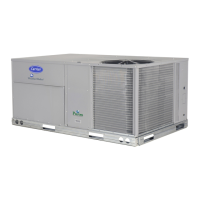45
Fig. 65 — Location of Non-Fused Disconnect
Enclosure (Size 16)
Fig. 66 — Handle and Shaft Assembly for NFD (Size 16)
CONVENIENCE OUTLETS FOR 50TC16 UNITS
Two types of convenience outlets are offered on the 50TC-D16:
non-powered and unit-powered. Both types provide a 125-v GFCI
(ground-fault circuit-interrupter) duplex receptacle rated at 15-A
behind a hinged waterproof access cover, located on the panel be-
neath the control box. See Fig. 67 and 68.
Fig. 67 — Convenience Outlet Location (Size 16)
Non-powered type
This type requires the field installation of a general-purpose
125-v 15-A circuit powered from a source elsewhere in the
building. Observe national and local codes when selecting wire
size and conduit requirements, fuse or breaker requirements
and disconnect switch size and location. Route 125-v power
supply conductors into the bottom of the utility box containing
the duplex receptacle.
Unit-powered type
A unit-mounted transformer is factory-installed to stepdown
the main power supply voltage to the unit to 115-v at the du-
plex receptacle. This option also includes a manual switch with
fuse, located in a utility box and mounted on a bracket behind
the convenience outlet; access is through the panel beneath the
control box. See Fig. 67.
The primary leads to the convenience outlet transformer are
not factory-connected. Selection of primary power source is a
customer option. If local codes permit, the transformer primary
leads can be connected at the line-side terminals on the unit-
mounted non-fused disconnect switch; this will provide service
power to the unit when the unit disconnect switch is open. Oth-
er connection methods will result in the convenience outlet cir-
cuit being de-energized when the unit disconnect switch is
open. See Fig. 69. On a unit without a unit-mounted discon-
nect, connect the source leads to the main terminal block
(TB1).
If the convenience outlet transformer is connected to the line
side of a field disconnect, the conduit provided with the unit
must be used to protect the wires as they are routed from the
transformer to the field disconnect. The end of the conduit with
the straight connector attaches to the field disconnect. The oth-
er end does not need to connect to the transformer; however,
the conduit must be routed so that all wiring is either in the
conduit or behind the access panel.
If the convenience outlet transformer is connected to the line
side of the factory disconnect option, route the wires through
the web bushing located on the bottom of the disconnect box.
For the load side wiring to the factory option disconnect, route
the wires through the hole on the right side of the disconnect.
Be sure to create a drip loop at least 6-in. long.
Test the GFCI receptacle by pressing the TEST button on the face
of the receptacle to trip and open the receptacle. Check for proper
grounding wires and power line phasing if the GFCI receptacle
does not trip as required. Press the RESET button to clear the
tripped condition.
WARNING
ELECTRICAL OPERATION HAZARD
Failure to follow this warning could result in personal inju-
ry or death.
Units with convenience outlet circuits may use multiple
disconnects. Check convenience outlet for power status
before opening unit for service. Locate its disconnect
switch, if appropriate, and open it. Lock-out and tag-out
this switch, if necessary.
Convenience
Outlet
GFCI
Pwd-CO
Fuse
Switch
Pwd-CO
Transformer
Disconnect
Access Panel

